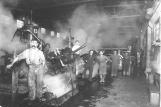36
Groundwood deckers20 October 1955
Powell River, British Columbia, Canada
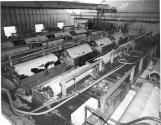 Credits:
Credits:PC-GW3
R.F. Metcalf, photographer
Dave Buchanan
37
In the manufacture of newsprint few people realize the multiplicity of occupations necessary for the conversion of the tall hemlocks and spruce trees of the Pacific Coast into that daily newspaper which is such a necessity in our daily lives. One of these occupations is that of the acid maker. Approximately 12 percent of every newspaper is sulphite pulp, produced chemically, by cooking to disintegration, hemlock chips in a solution of sulphurous acid and a compound known as calcium bisulphite. The acid maker is the man who is responsible for production of the sulphurous acid so necessary and vital to manufacture of newsprint.Wilfred Heritage, Acid Maker
The Digester, Nov-Dec 1948
38
Acid TowerCirca 1923
Powell River, British Columbia, Canada
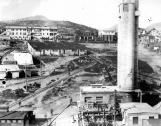 Credits:
Credits:P00516
Catalyst Paper, Powell River Division
39
...so we introduce a cooking process, whose sole purpose is to disintegrate these chips, leaving the fibres in their original length in the form of pulp. That is exactly what happens. The fibres are not soluble--and the rest of the chip is dissolved by the acid and steam which has been introduced into the cooking process. At the expiration of the "cook", the acid and other impurities are drained off and the sulphite fibres are left.A word about the cooking process, which is the focus around which all activities in the sulphite department revolves. When the chips leave the chipper machine they are carried by conveyor directly to huge chip bins. Below each of these bins is a huge cylindrical vat, known as a digester, into which the chips are fed. When the digester is filled with chips, it is sealed tight, save for a two-inch air vent. Then the cooking "liquor" --a mixture of sulphurous acid and calcium bisulphite is introduced. Steam, under initial pressure of 125 pounds to the square inch, is introduced from the bottom and driven through the chips to assist in cooking. From 20,000 to 30,000 gallons of "liquor" are used on each "cook" which averages 7 1/4 hours. The chips are cooked under a temperature which reaches 300 degree F. before being relieved. .......
At the end of the 7 1/4 hour period, the "blow valve" at the bottom of the digester is opened--and the disintegrated chips, now in the form of pulp, are shot by pressure into huge wooden tanks. Here the pulp is washed and impurities drained off, leaving it ready for passage through the various screening processes, before being finally introduced into the mixing tanks.
Powell River Digester
May-June 1950
40
Digester HouseCirca 1923
Powell River, British Columbia, Canada
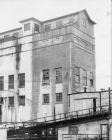 Credits:
Credits:FC024
The Powell River Mill Story, copyright Bill Thompson 2001.
41
We are all glad to see our friend and work mate Gambetti out and around again after being confined to his bed for the past few weeks. We hope that soon he will be his own self again, and begin to promenade the flume of he Grinder Room, as we surely miss his high stepping.While trying to find the reason for the smile on David Cummings' face, word came to hand that his wife had presented him with a fine baby girl. The slogan now is "keep on smiling."
Bill McGillivray came back from a trip up the lake a few days ago, with the following statement. We are going to give Billy's story and then the revised version. Here it is verbatim:
"Say, I believe Sid Murray has started a skunk farm up at his ranch. I got wind of it yesterday as I passed. You know the price of fur is high, and skunk is still higher. Sid is out to make a big per scent on his investment."
The truth is that Sid and his visitors have caught so many trout the last few weeks he has been using them for fertilizer. This mixed with some dope Sid is using for the extermination of the cutworm, gave off such an effluvium as to cause Billy to jump to conclusions.
Article entitled Grinder Room
Powell River Digester
Vol. 2, No. 10
October, 1923
43
Basically TMP is made from two main sources of chips. One is sawmill residuals- if you think about a log, when your're making squares, you cut off the edges. These edges are the best chip you can get because it's juvenile fibre - it's the growing part of the tree.The second source is in the grade of wood that comes out of the forest, it's called pulp wood - it's either got too many knots to make lumber out of it, or it's broken ends, so it's truly a bi-product of logging. Most logging is done to make finished lumber. But in the mix of the forest you can see crummy trees, bent trees, twisted trees - that's basically pulp wood.
Taped interview for
People of The White City
44
TMP Building8 July 1976
Powell River, British Columbia, Canada
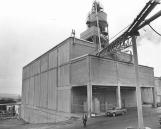 Credits:
Credits:P07934
Bryan Kyle, Photographer
Peter Cable
45
TMP is a mechanical groundwood really. It takes chips rather than a log and it grinds the chips between two metal plates, which have got serrations on them, so one plate goes in one direction, and the other plate in the other direction, and they just grind away and wear away the chips into a pulp. It's similar to groundwood, but it's got longer fibres than groundwood.I think the main advantage of TMP is it's easier to produce - it's not so labour intensive. There are still a few grinder rooms, but they're disappearing. G4 is still here, but it's being closed down this year. So we will be out of groundwood completely.
Taped interview for
People of the White City
46
Monitoring the TMPCirca 1987
Powell River, British Columbia, Canada
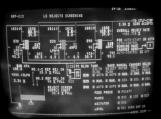 Credits:
Credits:S748
Ian Cameron, photographer
Peter Cable
47
Stock prep used to be the beater room, and it changed later on. It was just a name change because we were preparing the stock for the machines, and the beater room really didn't sound like we were doing anything as far as the machines go.There was no other operation in the mill like the old beater room. It was a good atmosphere. Everybody worked hard and they all worked together.
Taped interview
People of The White City
48
Stock Prep-Beater Room13 July 1951
Powell River, British Columbia, Canada
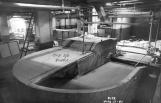 Credits:
Credits:A14-4-2
Ted Cooper
49
They had automatic beaters on 7-8 and 5-6; they had a huge beater on 5-6. It was completely different. But 7-8 had their own beaters, and they had one operator later on and they had a walkway between the beaters so he could monitor both at the same time. Then they put lights on and horns when the machine broke, because they had a signal that they were breaking, and they had automatic showers that went on right away, so it was different, but they still had plug-ups.I remember working on 5-6 as a helper. That was during the war. That was a busy job - they were wide machines, and there was one person to each beater, one on 5, one on 6 - this was the original beaters. That was a tough job - when they broke you had to really hustle because a sheet was almost 1.5 times as wide as number 1,2,3,4, and they were going that much faster - they were doing about 1100 feet a minute, and I think number 1-2 were doing about 660 feet a minute, so there was a lot of paper coming down.
Taped interview
People of The White City
